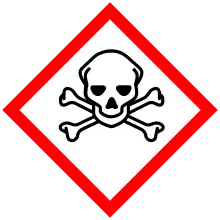 | |
| Names | |
|---|---|
| Preferred IUPAC name
2,6-Dichloropyridine | |
| Identifiers | |
3D model (JSmol) |
|
| ChEMBL | |
| ChemSpider | |
| ECHA InfoCard | 100.017.531 |
| EC Number |
|
PubChem CID |
|
| UNII | |
CompTox Dashboard (EPA) |
|
| |
| |
| Properties | |
| C5H3Cl2N | |
| Molar mass | 147.99 g·mol−1 |
| Melting point | 86–89 °C (187–192 °F; 359–362 K) |
| Boiling point | 211–212 °C (412–414 °F; 484–485 K) |
| Hazards | |
| GHS labelling: | |
  | |
| Danger | |
| H301, H315, H319, H335 | |
| P261, P264, P270, P271, P280, P301+P310, P302+P352, P304+P340, P305+P351+P338, P312, P321, P330, P332+P313, P337+P313, P362, P403+P233, P405, P501 | |
Except where otherwise noted, data are given for materials in their standard state (at 25 °C [77 °F], 100 kPa).
Infobox references | |
2,6-Dichloropyridine is an organohalide with the formula C5H3Cl2N. A white solid, it is one of six isomers of dichlorpyridine. It serves as a precursor to the antibiotic enoxacin.[1] 2,6-Dichoropyridine is produced by direct reaction of pyridine with chlorine. 2-Chloropyridine is an intermediate.[1]
Toxicity
References
- 1 2 3 Shimizu, Shinkichi; Watanabe, Nanao; Kataoka, Toshiaki; Shoji, Takayuki; Abe, Nobuyuki; Morishita, Sinji; Ichimura, Hisao (2007). "Pyridine and Pyridine Derivatives". Ullmann's Encyclopedia of Industrial Chemistry. Weinheim: Wiley-VCH. doi:10.1002/14356007.a22_399. ISBN 978-3527306732.
This article is issued from Wikipedia. The text is licensed under Creative Commons - Attribution - Sharealike. Additional terms may apply for the media files.